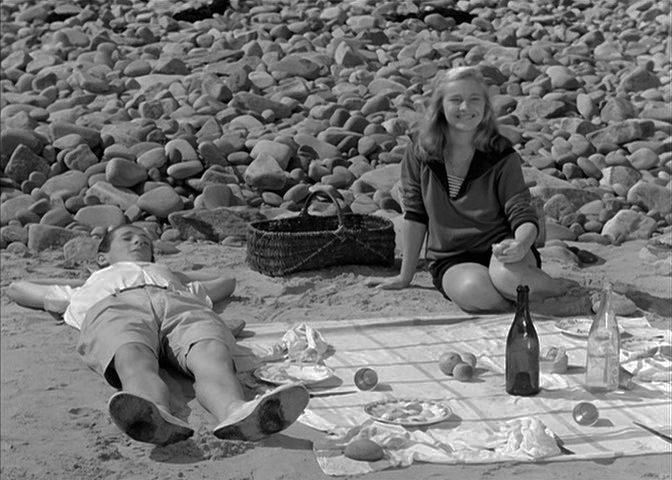Autant-Lara’s Le Blé en herbe is good at separating the dual aspects of love in Colette’s novel about adolescents and friends for years and learning about love while vacationing in Normandy. There are two parts to the narrative. In the first part, teenagers Philippe and Vinca fall in love and endure the pleasure and rough times of growing up to adulthood. In the second part, Philippe is seduced by Madame Dalleray and learns of the pleasures of adult sex.
There are other differences. At first, there is innocent sexuality. In Colette’s narrative, a key episode is a picnic that oozes latent sexuality, but nothing happens. But Claude-Autant-Lara’s has several beach scenes, among which the picnic is just another.
Colette’s picnic on a rocky beach is a metaphor for Phil and Vinca’s rocky relationship. Autant-Lara doesn’t get the point, and he situates them on a smooth sandy beach. To him, a beach is a beach. Colette writes that Philippe, Vinca, and her sister Lisette pack their picnic baskets and walk down the rocky cliffs like “explorers, to eat out of doors in one of the deep clefts in the cliffs: a time-honored pleasure. Autant-Lara’s beach is smooth sand below a hillock of wispy seagrass.
Colette is very specific about their lunch: sparkling cider and mineral water, a baguette for sandwiches of buttered lettuce, and cubes of gruyere, salt, ripe pears, and sardines. They are so adult; they use flatware and drink from glasses.
Autant-Lara’s picnic ends when Vinca leans over and tries to kiss Philippe. But sensing her nearness, he jumps up and moves away. When Philippe leaves Vinca on the beach, he climbs the dune and encounters Madame Dalleray, so the second and steamy half of the story begins.
See Claude Autant-Lara. Le blé en herbe [The Game of Love] (1954). Collette. Le Blé en herbe. Paris: Flammaron, 1923. Autant-Lara’s title was changed to The Game of Love for American distribution.

